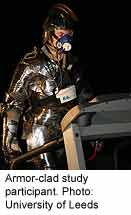
FRIDAY, July 22 (HealthDay News) — Heavy body armor worn in medieval times may have made soldiers feel safe, but it also forced them to expend twice as much energy as usual, according to a new study.
The steel plate armor of the 15th century, researchers pointed out, typically weighed up to 110 lbs and would have limited a soldier’s performance on the battlefield. As a result, they added, body armor may have played a role in whether or not a battle was won or lost.
“We found that carrying this kind of load spread across the body requires a lot more energy than carrying the same weight in a backpack,” said the study’s lead researcher, Dr. Graham Askew of the University of Leeds Faculty of Biological Sciences in England, in a university news release. “This is because, in a suit of armor, the limbs are loaded with weight, which means it takes more effort to swing them with each stride. If you’re wearing a backpack, the weight is all in one place and swinging the limbs is easier.”
To conduct the study, published July 20 in Proceedings of the Royal Society B, researchers measured the oxygen intake of fight interpretation experts from the Royal Armories Museum, who wore exact replicas of four different types of European armor during a range of walking and running exercises. By monitoring their breathing, the researchers were able to determine how much energy they used.
The study also showed that heavy steel body armor interfered with soldiers’ breathing by forcing them to take more frequent shallow breaths, rather than deep breaths.
“Being wrapped in a tight shell of armor may have made soldiers feel safe,” said study co-investigator Dr. Federico Formenti, of the University of Auckland in New Zealand, in the news release. “But you feel breathless as soon as you begin to move around in medieval armor, and this would likely limit a soldier’s resistance to fight.”
More information
The U.S. Centers of Disease Control and Prevention provides more information on measuring physical activity intensity.

